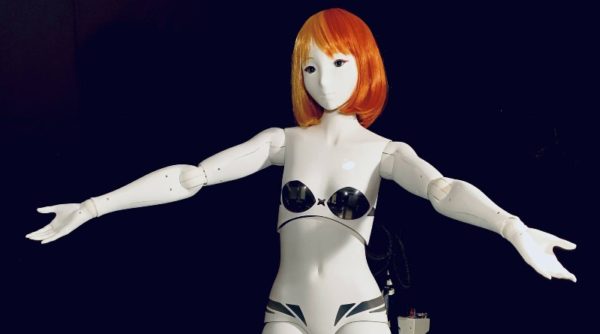You might’ve heard the name ‘Kosaka Cocona’ before. Sounds like a J-idol name, or an anime character, right? Close, but not quite. In 2017, she was released as a 45cm all-singing, all-dancing mini idol figure.
Cocona’s back for 2019… as a ‘Human Sized Motion Figure’.
Quiet, graceful – definitely not human
This fig’s really as tall as a human. As tall as a 155cm (5ft 2in) human. That’s a fairly average size for Japanese women, so you can’t deny that Cocona looks realistic.
She has 37 individual moving parts and directions: neck, elbows and wrists, down to knees and ankles. That’s more than the 45cm figure had… 3 more, to be exact. And Cocona still knows how to dance, and do tai chi.
An optional ‘Figure Drive’ system helps Cocona walk, at a normal human walking speed. It should also be possible to use her movements for making MikuMikuDance files (.pmx or .vmd).
It’s impressive how quiet her motions are. Smooth and delicate, but purposeful and clear. The key to how Cocona moves is a focus on ‘gestures’ – movement that means something, like waving or bowing.
And compared to when we last saw Cocona, she’s grown up a lot. A working figure more than 3x as big as the previous one, less than 2 years later? That’s crazy amazing. Thinking where this tech could be 2-5 years from now’s kinda scary.
On top of the motors and joints, Cocona’s hair and outfits can easily be swapped out. The smaller figure was designed with fixed twin buns, no way to restyle her. Human size means human clothes, accessories, and a bigger choice of wigs.

A maid outfit was the super obvious choice. The other outfits look good, too.
Perfect round joints, since 2001
Just like last time, Cocona’s been developed by a Japanese company called Speecys (say it like ‘species’). They work on motion figures, robots, and other 3D projects.
Some text on the Speecys website, and their Facebook page, is helpfully in English. They’re keen to take Cocona global. If there’s international interest, maybe dancing robot idol girls will visit your country too.

Speecys sums up their tech with this concept: “To put beautiful joints easily everywhere you need.” It’s a shame they don’t do hip replacements for humans, having beautiful joints sounds great to us.
The company’s already got patents secured: for the skeleton structure of their figures, the ‘skin’, and the rounded shape of the joints. When Cocona goes on sale, buyers’ll get the choice to choose from extras like silicone or resin finishes.
Yep, robots are taking all our jobs
There’s no need to start making room on your display shelf. Ultimately, Cocona’s designed to work. She’s a ‘professional entertainment system’ aimed at businesses.
If you were thinking she’d be your new permanent housewaifu, like Azuma Hikari inside the Gatebox system, sorry to burst that bubble.

At art shows, theme parks, events, and in other business settings, trust Cocona to keep her cool dealing with the public. We don’t think she even knows how to frown.
Through an app, Cocona’s voice and movements can be fully customised. She’ll say whatever you need her to say. It’s also possible to change how she looks – we’ve already seen more than 1 face.
Say ‘domo arigatou’ to a roboto today!
The ‘Human Sized Motion Figure’ version of Kosaka Cocona wasn’t officially on sale when we wrote this. We bet any interested parties are using this time to prep their wallets.
She’s gonna cost at least 20 million yen plus tax (that’s £140k, $183k – exchange rates might change). That’s for the standard body and software. Custom options add to the price.
Cheaper, mass market options for lovers of weird Japanese robotech and AI:




